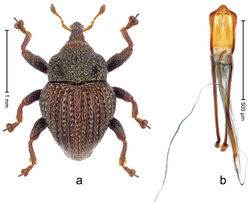Trigonopterus pseudosumbawensis
| Notice: | This page is derived from the original publication listed below, whose author(s) should always be credited. Further contributors may edit and improve the content of this page and, consequently, need to be credited as well (see page history). Any assessment of factual correctness requires a careful review of the original article as well as of subsequent contributions.
If you are uncertain whether your planned contribution is correct or not, we suggest that you use the associated discussion page instead of editing the page directly. This page should be cited as follows (rationale):
Citation formats to copy and paste
BibTeX: @article{Riedel2014ZooKeys, RIS/ Endnote: TY - JOUR Wikipedia/ Citizendium: <ref name="Riedel2014ZooKeys">{{Citation See also the citation download page at the journal. |
Ordo: Coleoptera
Familia: Curculionidae
Genus: Trigonopterus
Name
Trigonopterus pseudosumbawensis Riedel sp. n. – Wikispecies link – ZooBank link – Pensoft Profile
Diagnostic description
Holotype, male (Fig. 61a). Length 1.94 mm. Color of antennae, legs and elytron ferruginous, remainder black. Body in dorsal aspect with marked constriction between pronotum and elytron; with distinct constriction in profile. Rostrum in basal half with median ridge and pair of submedian ridges, in apical half rugose-punctate; epistome with transverse, subangulate ridge. Pronotum with indistinct subapical constriction; disk coarsely punctate-rugose, sparsely setose; in basal half with pair of sublateral, kidney-shaped impressions. Elytra with striae deeply impressed, each with row of short, suberect scales; intervals costate, subglabrous; apex narrow. Femora with small tooth; metafemur subapically with stridulatory patch. Abdominal ventrite 5 flat, coarsely punctate. Penis (Fig. 61b) with sides of body subparallel; in apical quarter with sides angularly projecting, abruptly converging to slightly extended apex, medially with sparse setae; transfer apparatus flagelliform, 2.3 × longer than body; apodemes 2.3 × as long as body. Intraspecific variation. Length 1.52–1.94 mm. Color of elytra ferruginous or almost black. Body relatively slender or rather roundish. Penis with flagelliform transfer apparatus 2.3–2.4 × longer than body; apodemes 2.3–2.4 × as long as body.
Material examined
Holotype (MZB): ARC3602 (EMBL # LM656032), West Nusa Tenggara Prov., Sumbawa, Batu Dulang, Gn. Batu Pasak, sample 3, S08°37.524', E117°15.423', 1385 m, 12-IV-2010. Paratypes (SMNK): Sumbawa, Batu Dulang, Gn. Batu Pasak: 2 exx, ARC3604 (EMBL # LM656034), ARC3643 (EMBL # LM656064), ARC3646 (EMBL # LM656067), ARC3651 (EMBL # LM656069), same data as holotype; 1 ex, ARC3657 (EMBL # LM656075), sample 5, S08°37.005', E117°15.790', 1320 m, 18-IV-2010.
Distribution
West Nusa Tenggara Prov., Sumbawa (Batu Dulang). Elevation: 1385 m.
Etymology
This epithet is based on the Greek prefix pseudo (false) and the name of Trigonopterus sumbawensis Riedel, sp. n., a sibling species.
Notes
Trigonopterus pseudosumbawensis Riedel, sp. n. was coded as “Trigonopterus sp. 442”.
Original Description
- Riedel, A; Tänzler, R; Balke, M; Rahmadi, C; Suhardjono, Y; 2014: Ninety-eight new species of Trigonopterus weevils from Sundaland and the Lesser Sunda Islands ZooKeys, (467): 1-162. doi
Images
|
